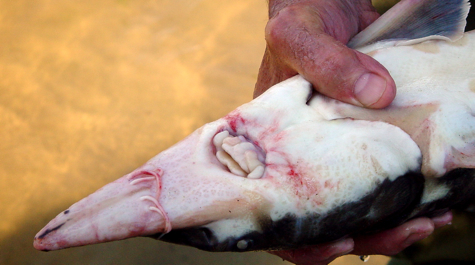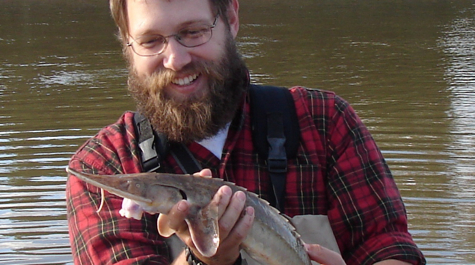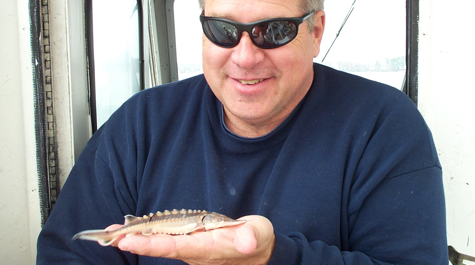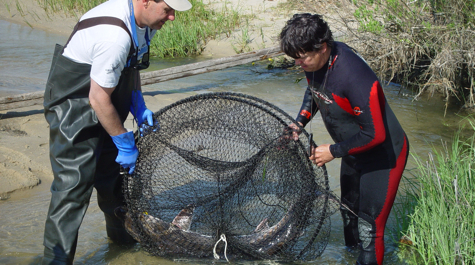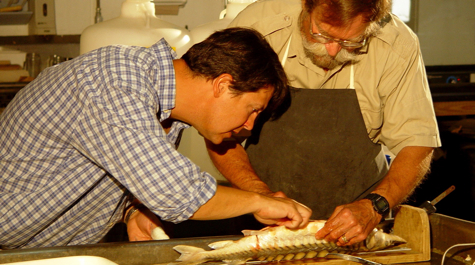Atlantic Sturgeon
Old Fish, New Fish
Atlantic sturgeon are members of an elite group of fishes whose relatives have been around since the time of the dinosaurs. While the fossil record of sturgeons dates back at least 85 million years, only 25 species of these "living fossils" persist worldwide. Atlantic sturgeon are therefore a unique and important part of the fauna of Chesapeake Bay.
But in just 400 years since Europeans colonized the New World, overfishing and habitat destruction have pushed sturgeon to extinction or near-extinction in rivers all along the Atlantic seaboard. Similar pressures have devastated sturgeon populations across the world, and virtually all species are in peril.
VIMS research is now playing a critical role in efforts to restore this ancient species to Chesapeake Bay and its tributaries—with a particular focus on the James River.
The research is now led by VIMS Associate Professor Eric Hilton, an internationally recognized expert on sturgeon evolution who joined the VIMS faculty in 2007. He has studied the anatomy, taxonomy, and evolution of sturgeons worldwide for more than 15 years. Sturgeon reseach at VIMS was initiated by now-emeritus professor Jack Musick in the 1970s, and was spearheaded between 2005 and by Chris Hager, a Fisheries Bycatch Specialist with the Sea Grant Marine Advisory Program at VIMS.
A "Triple Whammy"
Musick says that sturgeon—an anadromous species that resides in the ocean but enters freshwater rivers to spawn—have suffered from a "triple whammy."
First, VIMS research shows that sturgeon historically preferred to lay their eggs just below the fall line—the upstream extent of navigation on local rivers. Unfortunately for these fish, that's exactly where we have built a string of major cities—including Richmond on the James River and Washington, D.C. on the Potomac. "So these fish naturally spawn where there's been a lot of habitat degradation," says Musick.
Second, the widespread deforestation that accompanied the shift to European-style agriculture fed vast quantities of silt into Virginia's previously clear tidal rivers. "Sturgeon prefer to lay their eggs on gravel banks," says Musick. "Clearing of forests for farming caused many of these banks to silt over." There was also a major effort in the 1830s to remove the banks from the river to enable shipping.
Last, sturgeon suffer from their low reproductive potential: females don't reach sexual maturity until they're around 12 years old, and they only spawn every 2 to 6 years. "These demographics make sturgeon very vulnerable to over-fishing and stock collapse," says Musick. "Sturgeon were overfished and virtually clear-cut by fisheries in the last two decades of the 19th century, and have not been able to recover since."
Research for Recovery
VIMS researchers continue to collaborate with other state and federal scientists, as well as local citizens' groups and commercial anglers, to overcome the challenges to sturgeon recovery.
Hager began his research by partnering with local commercial fishermen, the US Fish and Wildlife Service (USFWS), and the Army Corp of Engineers' Engineer Research and Development Center. They used acoustic tracking technology to throw light on sturgeon abundance, habitat use, behavior, and seasonal movements within local waterways. They also studied numerous parameters related to sturgeon bycatch in Virginia's gill-net fisheries. These efforts led to development of gillnets that reduce the retention of sturgeon but maintain catch rates of targeted species. Research projects were funded in collaboration with fishermen through the Fisheries Resource Grant administered by Virginia Sea Grant's Marine Advisory Services Program. He partnered on these studies with Matt Balazik, a graduate student at Virginia Commonwealth University, Chuck Frederickson of the James River Association, and Albert Spells of the USFWS.
Musick has collaborated with Hager, his graduate students, technician Tara Bushnoe, and Dr. Donna Bilkovic in VIMS' Center for Coastal Resources Management to locate and map the gravel beds that sturgeon prefer for their spawning and nursery grounds. Because many of these beds are now buried by silt, their efforts required use of side-scan sonar to peer beneath the seafloor. This effort was funded largely by USFWS and the NOAA Chesapeake Bay Office.
Hilton provides the broad expertise of sturgeon biology that is needed to help identify unique aspects of East Coast Atlantic sturgeon stocks. The morphological, genetic, and behavioral structure of Atlantic sturgeon, and sturgeon species generally, are unclear and hotly debated. Atlantic sturgeon are highly migratory, and this type of information is key to ongoing efforts for sturgeon restoration.
Sturgeon Reef
These VIMS' studies laid the groundwork for a 2010 milestone in sturgeon restoration—a plan by the James River Association, partnering with Virginia Commonwealth University and Luck Stone, to construct an artificial spawning reef for sturgeon in the James River.
This project—given the green light by the Virginia Marine Resources Commission in January 2010—used large chunks of granite to build an artificial spawning reef at the Turkey Island Cutoff, near the Presquile National Wildlife Refuge. The 70 X 300-foot reef rises 2-feet above the muddy bottom, hopefully giving the few remaining sturgeon a fighting chance at reproduction. Researchers with the Virginia Sturgeon Restoration Partnership are now monitoring the success of this structure. All involved hope that some of the fish that use it will be spawning females.

